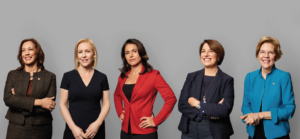
More women than ever are running for president, and their gender presents unique difficulties.
Photo courtesy of Marie Claire
Although the 2020 presidential election is still over a year and a half away, a number of candidates have already entered the race for the Democratic presidential nomination, and this year’s group is noticeably different from those in years past. The 2020 race has more women running for a single party’s nomination than any previous presidential election. These women include author Marianne Williamson, Congresswoman Tulsi Gabbard, as well as Senators Kirsten Gillibrand, Kamala Harris, Amy Klobuchar, and Elizabeth Warren. The fact that there are more women running than ever before shows a positive shift towards more equitable representation of the American people, but it also brings about its own particular challenges for these female candidates.
While the quantity of women running in this election is historical, it is not completely unheard of for a woman to be given the Democratic presidential nomination. The first, and only, woman to do this was Hillary Clinton during the 2016 presidential campaign. Through her campaigning, Clinton was able to garner the support of women across the country, even using the campaign slogan, “I’m with her” to highlight the fact that she would be the first female president if she won the election. Throughout this upcoming race, many will try and draw parallels between Clinton’s campaign and the campaign of the 2020 female candidates, but it is the differences between their campaigns that are much more important than their similarities. Due to the fact that she was the only woman running for her party’s nomination, Clinton automatically had a good percentage of voters that were liberal women. However, the number of women running this year has forced the candidates to differentiate themselves not by their gender, but by their actual policies in order to draw the liberal women’s vote.
In addition, the historic number of women running for president also leads to a much higher chance that the United States of America will have their first female vice president. Although this will clearly not be as hyped or lauded as being the first female president, it is still a historic achievement considering that the highest public office a woman has ever held in the United States has been Speaker of the House of Representatives. Whether the presidency, vice presidency, or both are given to a woman, it will represent a new wave of possibilities for women in America. If a woman is able to hold such a high office, it opens up doors for women everywhere in a country where they are still seen as inferior, blatantly shown by the wage gap or the fact that 2019 marks a historical feat just by having six women running for president.
Although this increase in female candidates symbolizes a shift in the way Americans view women and traditional gender roles, it in no way means that this campaign will be easy for any of these women. They are competing to run a country that is comprised of 51% women yet only has a national representative body with a female makeup of 25%. However, the recent midterms did show that marginalized American people are increasingly coming out to vote, resulting in a more diverse Congress. However, Americans have shown time and time again that they resist change. The tides are turning, but are they fast enough? It is a time to celebrate the growing representation of marginalized voices, but it is just as important to acknowledge that in order to run a successful campaign, these women will have to fight an uphill battle, solely because of their gender.




